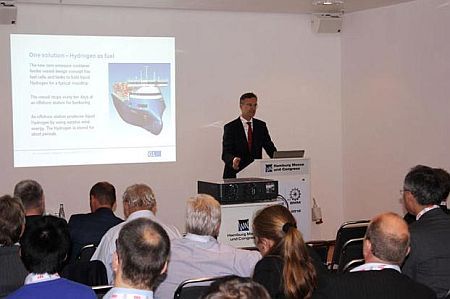
Technical and operational efficiency improvements may lower CO2 emissions from ships by as much as 20 per cent across the global fleet. But even such marked gains in efficiency will not stop the steady increase of total emissions from shipping or meet the ambitious reduction targets of the future. At his presentation at GMEC (global maritime environmental congress) yesterday, Dr Pierre C Sames, Germanischer Lloyd’s Head of Research and Rule Development, showed how through innovative design and a shift to renewable energy sources the maritime industry could look to a zero emission future.
Part of the “CO2 and greenhouse gas emissions” session at GMEC, Dr Sames’ presentation “The zero-emission perspective”, examined the potential use of fuel cells in shipping, the use of renewable energy to produce hydrogen for use as fuel, the economics of the technology and looked at two concept designs for fuel cell driven, hydrogen fueled vessels.
In his presentation Dr Sames set out GL’s design concept for a zero-emission container feeder vessel (pictured). The concept design, which targets Northern European feeder services, uses liquid Hydrogen as fuel to generate power with a combined fuel cell and battery system. The design concept addresses typical feeder services with a full open-top 1,000 TEU intake and 160 reefer positions at a service speed of 15 knots. The vessel is powered by a fuel cell system which delivers up to 5 MW to two podded propulsors. A battery system provides peak power. Multiple type C tanks hold 920m3 of liquid Hydrogen to facilitate a roundtrip equivalent to ten full operating days.
With strict limits on sulphur emissions set to come into effect in 2015 in the Baltic Sea, ferry owner and operator Scandlines turned to FutureShip, GL’s consulting subsidiary, to help them develop a fuel cell driven concept design with for their Baltic ferry lines. The design is for a double-ended ferry for with space for 1500 passengers and 2200 lane metres for vehicles. Located on deck, the hydrogen tanks can accommodate 140 cubic metres – enough for a passage of 48 hours, Dr Sames noted. The fuel cells offer a rated power of 8300 kilowatts and the storage batteries a capacity of 2400 kilowatt-hours. The nominal speed of the ferries is set at 17 knots – the parameter used for sizing the fuel cells. To accelerate up to 18 knots, the four 3MW pod drives draw additional current from the batteries. Flettner rotors on deck add to the energy efficiency of the design.
For a true “zero”-emission vessel, it is necessary to go beyond the emissions from the ship itself and account for the production of its fuel as well. The GL design concept proposes using wind energy to produce LH2. A 500 MW wind farm could produce up to 10,000 tonnes of liquid hydrogen from surplus power it is unable to feed into the gird. GL estimates that liquid hydrogen produced by wind power could be commercially attractive between 2020 and 2030, provided that the price of MGO increases beyond US$2000/t.
In 2020, current estimates are that approximately 3GW of offshore wind energy generation capacity will be installed in the German Exclusive Economic Zone alone. But up to 30% of the generated power may not be put into the grid and therefore could be available for Hydrogen production (up to 3600 GWh/a). Two recently opened projected in Germany, Dr Sames pointed out, showed how using Hydrogen to store surplus energy was already a viable technology. The two plants, at Prenzlau and Falkenhagen, have been in operation for the better part of a year and use wind energy to generate Hydrogen through electrolysis, which can be then stored and used to power vehicles (Prenzlau), or fed directly into the natural gas pipeline system (Falkenhagen).
We use cookies to improve your experience. By continuing to use our site, you accept our Cookies, Privacy Policy,Terms and Conditions. Close X